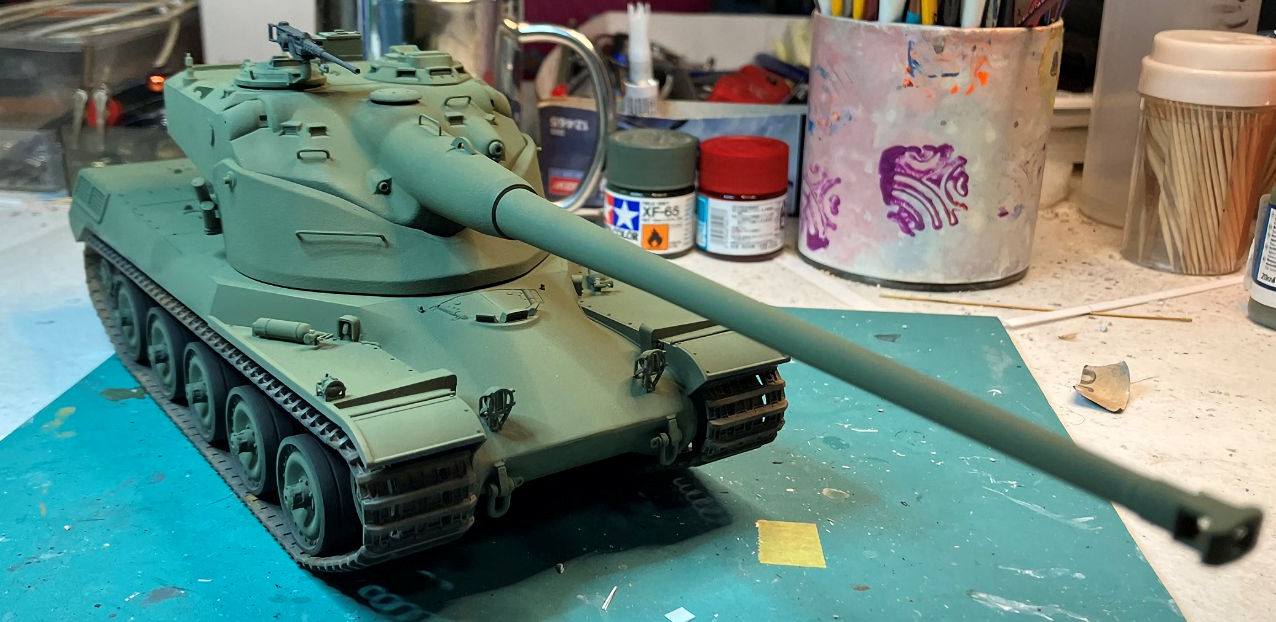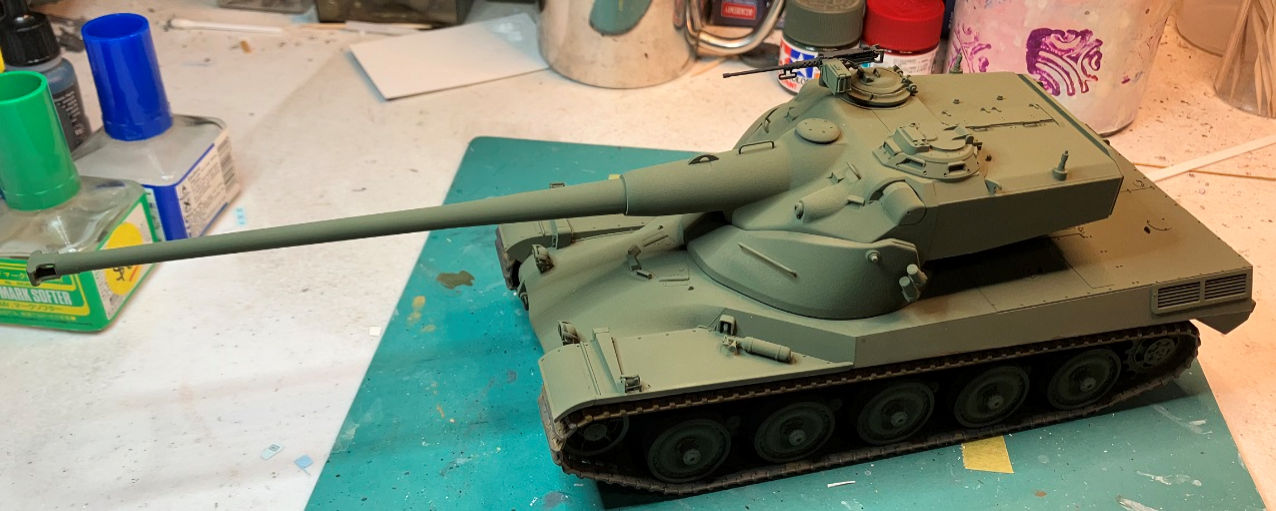To tell the story of this tank, I really need to digress and tell a couple of other tales first.
During the September 1945 Berlin Victory Parade, the Soviets presented their latest toy, The JS-3. This was the latest in the line of Stalin heavy tanks featuring a 122mm gun. Conventional history would tell us that the appearance of this tank would send shock waves through the Western allies as there was nothing to counter it. This is bullshit because said allies had been gearing up to counter the German heavies in the 100 tonne class that were expected to appear in 1946. Both America and Britain had heavy tank prototypes and heavy tank destroyers in development. France however had no tank industry but at least had a design.
In America, heavy tanks based on the M26 Pershing had been developed mounting guns including 105, 120 and 155mm. The ordinance department had a pathological hatred for heavy tanks as four Shermans could be shipped for every heavy tank and the Shermans had worked okay against the King Tiger. (Who won the war anyway?). The fact that the Sherman was not a match on a toe to toe basis didn’t matter when you could build 100 for every Tiger produced. Despite this the Army had recognized that there were shortcomings with both the Sherman and the Pershing. Pershings were reclassified as mediums immediately after the war and quickly retired only to be brought back to serve in Korea. The Americans started a new program to produce new light, medium and heavy tanks. This program would result in the M41 Walker Bulldog, M47 Patton and M103 heavy tank. The M103 utilized a converted 120mm AA gun which was more than adequate for the task.
In Britain, they were a bit less inclined to throw away the lives of their tank crews. The British did not categorize tanks as light, medium or heavy, instead recognizing the role as either an Infantry tank or a cruiser. Towards the end of the war, Montgomery had requested a “Universal” tank, being a tank that could fulfill all roles. This requirement had led to the A41 better known today as the Centurion. As good as it was, the Centurion was still only armed with the 17lbr but bigger and better guns were in development. There was also the A45 Infantry support tank in development however only the hull and automotive components were ready by the end of the war. The appearance of the JS-3 pushed the British into developing a new role for a tank. This was an overwatch tank, a tank with a long range weapon that could take out heavies from a long distance. This was similar to the thinking that produced the Sherman Firefly. The A45 chassis was available so this was used. A big gun was not available so the American 120mm gun was used in a new cast turret. This tank became the Conqueror.
Prior to WW2, France had been the second largest tank producer after the Soviet Union. The French tanks were mostly crap and were poorly deployed hence they were easily beaten. During the occupation a heavy tank was designed in secret. This was the ARL-44 which was not a good design but was useful in that it allowed the French armaments industry to focus on rebuilding after the war. Until the ARL-44 was complete, France had to rely on whatever they had captured or handouts from the other allies.
The ARL-44 was not a good tank even by French standards, it was a death trap. It was built from pre-war left-over parts, the salvaged armour from a sunken battleship and a German engine. Despite all its faults, the ARL44 was the most powerful tank fielded by any western ally until the appearance of the M103 and Conqueror. It was obvious that a new design was needed.
Once the ARL-44 program was completed, the French moved on to other designs including light tanks and armoured cars. The Panhard EBR and AMX-13 were both reasonably successful light vehicles. The Panhard had been built on a pre-war chassis but the AMX-13 was new. Both featured a revolutionary development, the oscillating turret. In this design, the gun was fixed to the upper half of the turret and this half of the turret rotated in trunnions mounted in the sides of the lower turret. This had the advantages of reducing the area required for the gun to recoil during elevation or depression so larger guns could be mounted. The AMX13 managed to mount the 75mm Panther gun, (a French copy) in a 13 tonne vehicle. This layout also enabled an auto-loader to be fitted as it could be easily aligned with the axis of the gun. The turret roof was generally closer to the gun enabling a lower hull down profile and greater depression than a conventional layout but overall the vehicle profile was higher. Firing the 75 in a 13 tonne vehicle was exciting, to say the least. The French had a different idea how to deploy these tanks and they were used more as self-propelled anti-tank guns similar to the German wartime Marder series. Traditional scouting was performed by armoured cars.
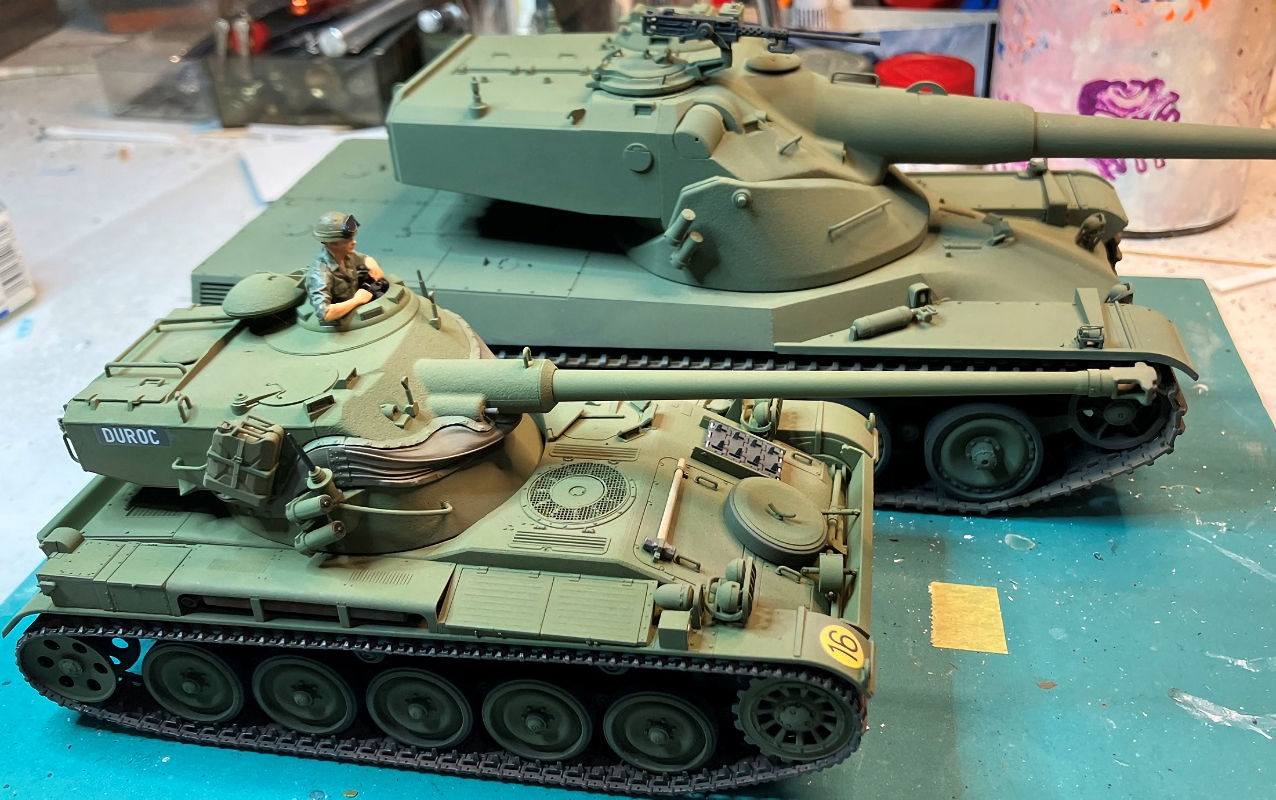
AMX-13 and AMX-50B
The appearance of the AMX-13 created a bit of a fad amongst the western tank producing communities. Soon the Americans and a lot of smaller nations were both fiddling with oscillating turrets. Most of these projects would eventually peter out. The AMX-13 and Panhard were the operation vehicles with manned oscillating turrets. In more modern times, unmanned gun versions are being tinkered with. One such vehicle is the M1128 Stryker MGS.
This brings us back to the ARL44 replacement. After the war, France was littered with wreaked tanks. Among these, there were numerous Panthers, Tigers and King Tigers. So many Panthers were in France that they were able to field 50 within their own forces. These were prone to breakdown and as parts soon ran out, they were replaced by the ARL44. Compared to the ARL44, the Panther was impressive, the King Tiger even more so. The French needed a new tank so the King Tiger was used as a basis. This design program commenced in March 1945. The new tank was to have the firepower of the King Tiger, the armour of the Panther, the reliability of the Sherman and the mobility of the T34, all whist weighing less than the M26.
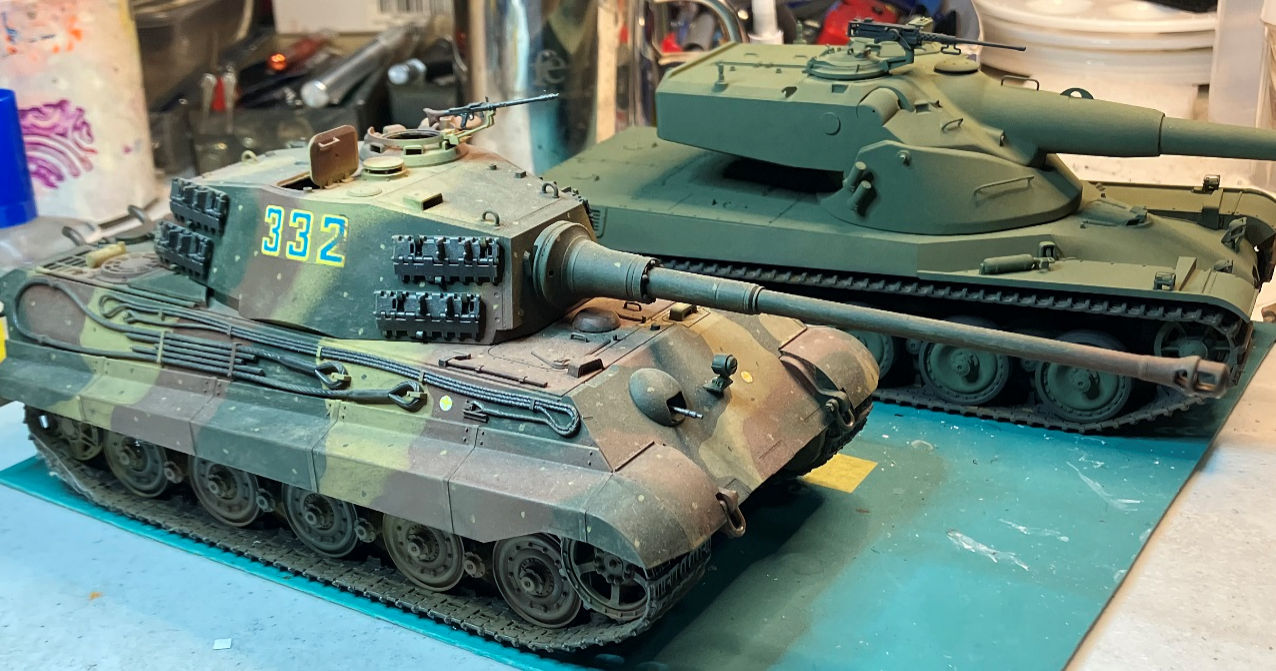
King Tiger and AMX-50B
The new vehicle was to be 30 tonnes and have a 90mm gun. By 1949 when the first prototype emerged, the weight had blown out to 50 tonnes. The first prototype looked like a shrunken king tiger. It used a German engine, German transmission, German brakes, backwards swing arms on one side, interleaved roadwheels and the same engine deck as used on the King Tiger. The turret was also very King tiger like and mounted a 90mm gun. The early prototypes were of welded flat plate construction.
The first prototype was soon followed by a second, this one mounting a 100mm gun. These two prototypes were tested until 1952. The revolutionary oscillating turret had in the meantime appeared. This turret was seen as a means to keep the weight low but still have a large gun. The two prototypes appear to have had their conventional turrets replaced with oscillating turrets at some point.
After 1952, two more new prototypes built, each with slightly different features. These featured cast nose armour. They retained the German automotive features but varied in the gun, secondary armaments, sights etc. The fourth prototype had the American 120mm gun. This gun had a problem. The shells were nearly 6ft long and weighed enough that a single crewman could not load the shell. This was solved in other tanks by using two loaders and separate cartridges and shells. The oscillating turret could be fitted with an autoloader removing the need for these crewmen. There were four crew, two in the lower hull. The fourth crew member was a radio operator but was there to help in loading the autoloader cassettes. In this form testing continued until 1955. Testing was fairly successful although the tank was underpowered and the weight had again blown out to nearly 70 tonnes. The Fourth prototype was heavily armoured with armour equivalent to the M103 and Conqueror but still thinner than the JS3. Various modifications to the lower turret had caused the height to blow out of all proportions. It now towered over the M47, itself a notoriously high tank.
A new lowered chassis prototype was introduced in 1956. This had a cast nose and reduced the height of the hull by several feet. It appears that the turret from the fourth prototype was used. This had the 120mm with 18 rounds in the autoloader. A 20mm coax was fitted with the idea it could engage smaller targets to save on the main gun ammo. It had another 7.5mm coax MG and a .50 cal on the roof. This vehicle was tested until 1958. The AMX50 was very nearly ordered into production however the production vehicle would have a supercharged engine delivering 1200CV.
By 1958, the project was dead.
There were several factors that killed it. In no particular order, the engine was unreliable unless limited to 850CV, this severely limited mobility and speed. A bigger engine could not be fitted as the engine compartment was too small. A team of 80 German engineers including Professor Maybach had been sent to France to fix it. They failed and consequently removed any mention of this project from the company records. The turret could not be sealed against chemicals or radiation. The overlap between the upper and lower turret was extremely susceptible to damage, a single hit in that area would jam the turret. The autoloader could only be loaded from outside, once empty the crew would need to disembark to reload. Foreign orders never eventuated.
The biggest single factor was the Yanks, dumping their unwanted M47s on anyone that would take them. The 90mm in the Patton was good enough. France received 856 Pattons under the Military Assistance Program. The AMX-50 was not a total waste of time. Several components were used for the later AMX30 program. The French were the first Western nation to drop the heavy tank designation. The future was to be for main battle tanks. The M103 and Conqueror made it into service but soon went the way of the dodo, killed by developments in missiles and HEAT rounds.
The last prototype was preserved. It resides in the Saumur tank museum in France.
It was trés French, trés revolutionary and trés useless.
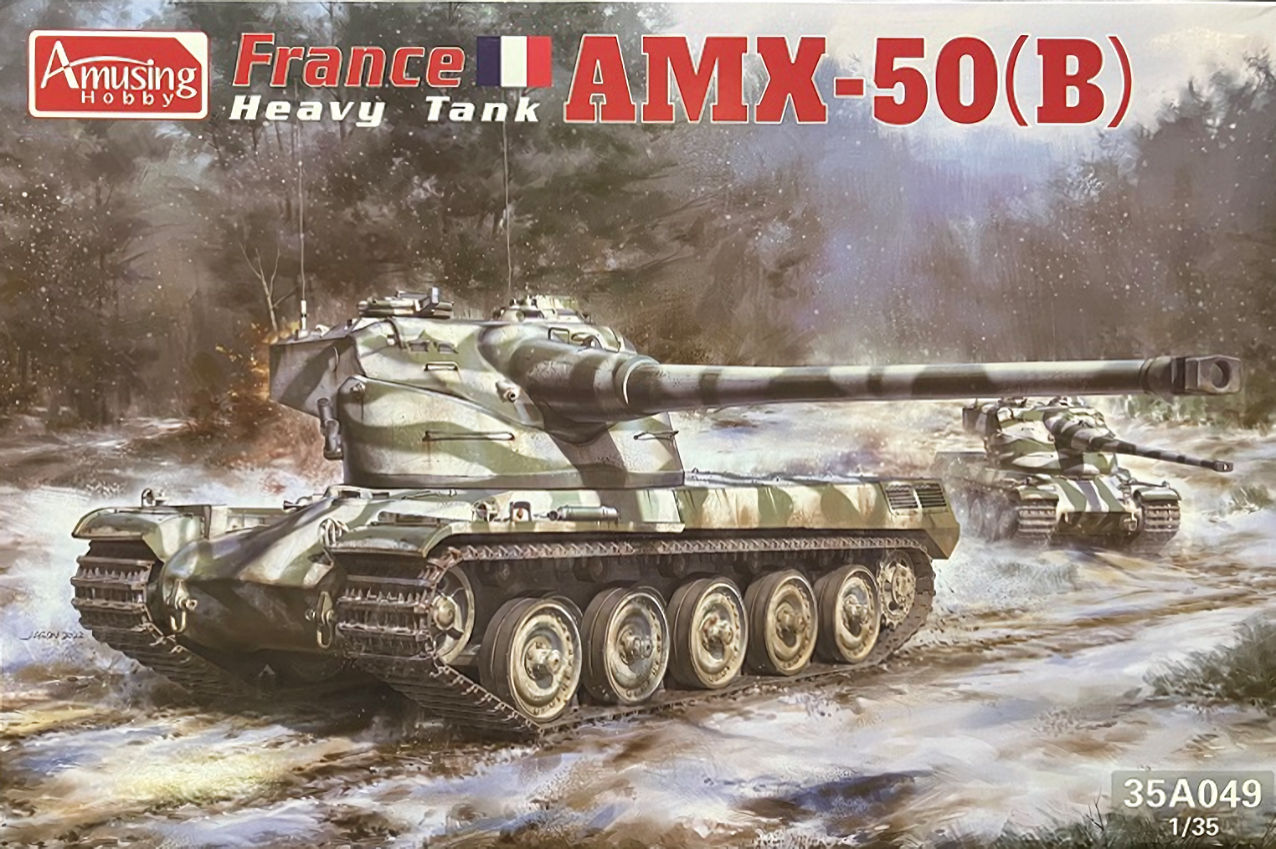
The kit
Amusing Hobby are a fairly new player specializing in kits of esoteric vehicles aimed towards the video game market. They are in most cases true to the original and detailed enough to appeal to the average modeler. The AMX50 is quite new. The model is of the vehicle preserved in Saumur. The kit is a conventional injection molded plastic model with a small etch metal fret. The tracks are link and length. The instructions are in colour for the schemes and include a page showing a blueprint for vehicle. Colour callouts are for Mig paints. A decal sheet of national markings is provided but the prototype is unmarked. Quality is good, fit is good and construction is straightforward.
As usual, I ignored the instructions and assembled the hull first. This is to ensure everything is square before adding the various governs as trying to fit a fully assembled upper and lower hull is fraught with peril. In this case, the upper and lower hulls and the rear plates fit together accurately with only a tiny joint at the front visible. A smear of Mr Surfacer was applied and the joint spackled with a brush when partially dry to preserve the cast texture.
After this the running gear was added. The swing arms are keyed but are touch loose. I aligned the end of the swing arm with the bottom of the hull. The swing arms alternate long and short and one side is backwards so you will need to be careful with the sequence. There are 36 road wheels all up, with two wheels per station assembled as a double wheel. Four are at the back, five at the front. Idlers and return rollers were added. The drive spockets were placed with one tooth pointing directly upwards.
Next the track was added. This is in individual links for any bends and in lengths for straight section. There is no provision for sag. I start with the three lengths for the top run. When partially dry, the last link was placed on the top tooth of the drive sprocket. I then added individual links around the idler until a short length was added to bridge to the first road wheel. two individual links went around this road wheel and joined to the two long lengths for the bottom run. This went to the back road wheel, another two links going around and joining up with a string of links going up to the top of the sprocket. It somehow managed to fit perfectly but this is not how the instructions show how to do it.
With the tracks on, the rest of the external parts were added although there are not many of those. There are photo etch engine grills, light guards and a small fitting on the headlight. The fit of parts is very good. The part numbers of the PE light guards are reversed in the instructions. There is a little tab that hangs low and goes to the inside. There are no lenses for the main headlamps provided so I added some left overs from an AFV Centurion which fit perfectly.
The turret is next starting with the upper. This is broken down as a mantlet, upper rear, lower rear and back. There is hole to be drilled in upper rear and then the part can be assembled. The turret lower is two parts which sandwich the upper and the fit is not good particularly at the front. These were superglued from the rear for extra strength. The joins were puttied and spackled to match the cast surface. The main gun is supplied in two halves and the seam also needed some attention. The various governs were next including the hatches, MG, smoke dischargers etc. There are a number of grab handles that need to be added. These are delicate and attached to the sprue with multiple large points. In my ham-fisted ineptitude, I managed to break several when removing from the sprue. These were replaced with wire.
Painting
Unfortunately only Mig paints are specified. Fortunately, it’s a prototype and only came in one colour. Basic green. The surviving vehicle is in a dark bronze green. The actual vehicles appear much lighter. Period colour photos are rare and generally inconsistent. I settled on Tamiya Nato green being the colour specified for the AMX13 of the same period. The instructions feature a dessert scheme and a winter scheme. There are no photo references for either apart from game footage. French roundels and flags are provided as decals but again there are no photo references.
As usual, everything below the guards was painted in Nato black. The green was sprayed over the top of the vehicle. The wheel centres and visible suspension components were also painted green. The tracks where then sprayed with dark earth. Once the tracks were dry, they were given a heavy wash of burnt umber rust pigments mixed with metho. As the wash dries, the pigments will actually rust and are a close match to the actual colour of unused aged tracks. That was it for spraying.
The next step is to brush paint the details such as the lights, MG, fire ext and periscopes. The wearing parts of the track, sprocket and idler were dry brushed with GS H18 steel.
Steve Pulbrook
January 2024
